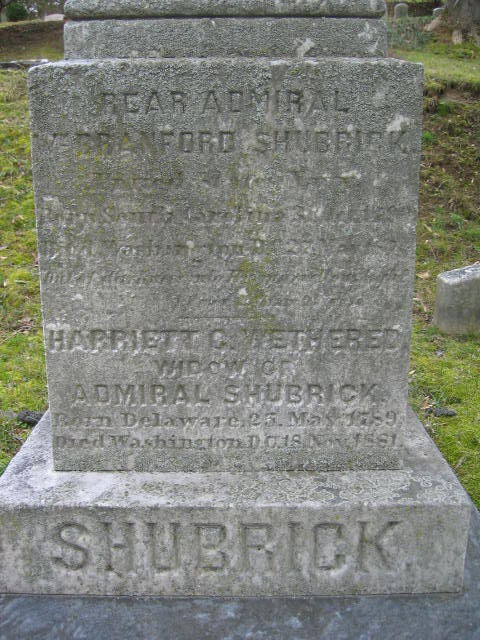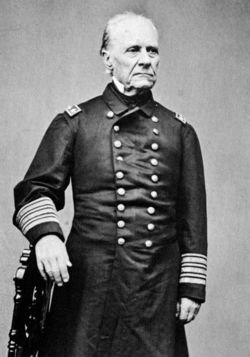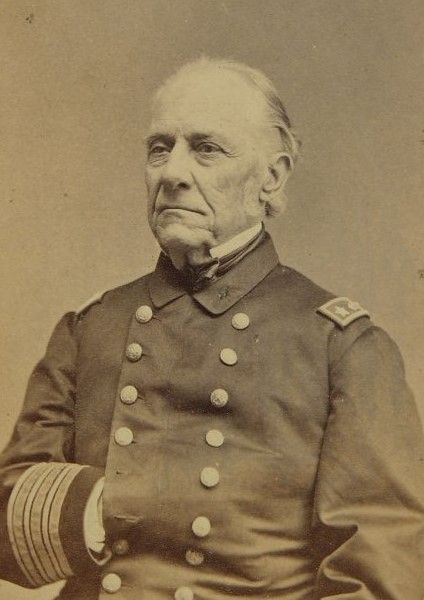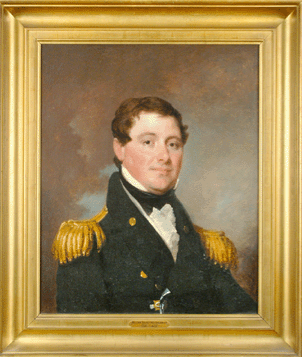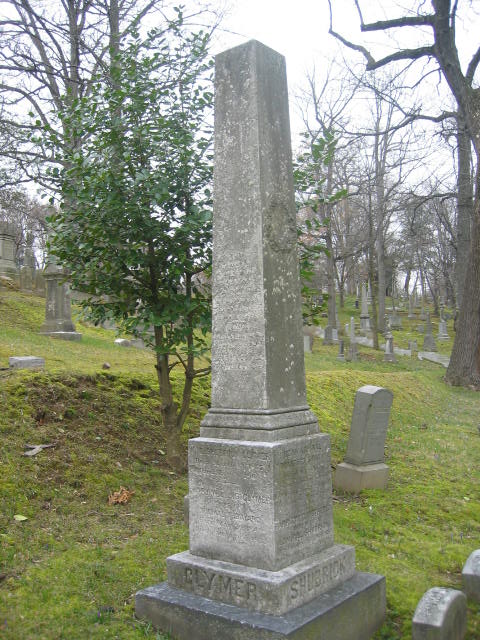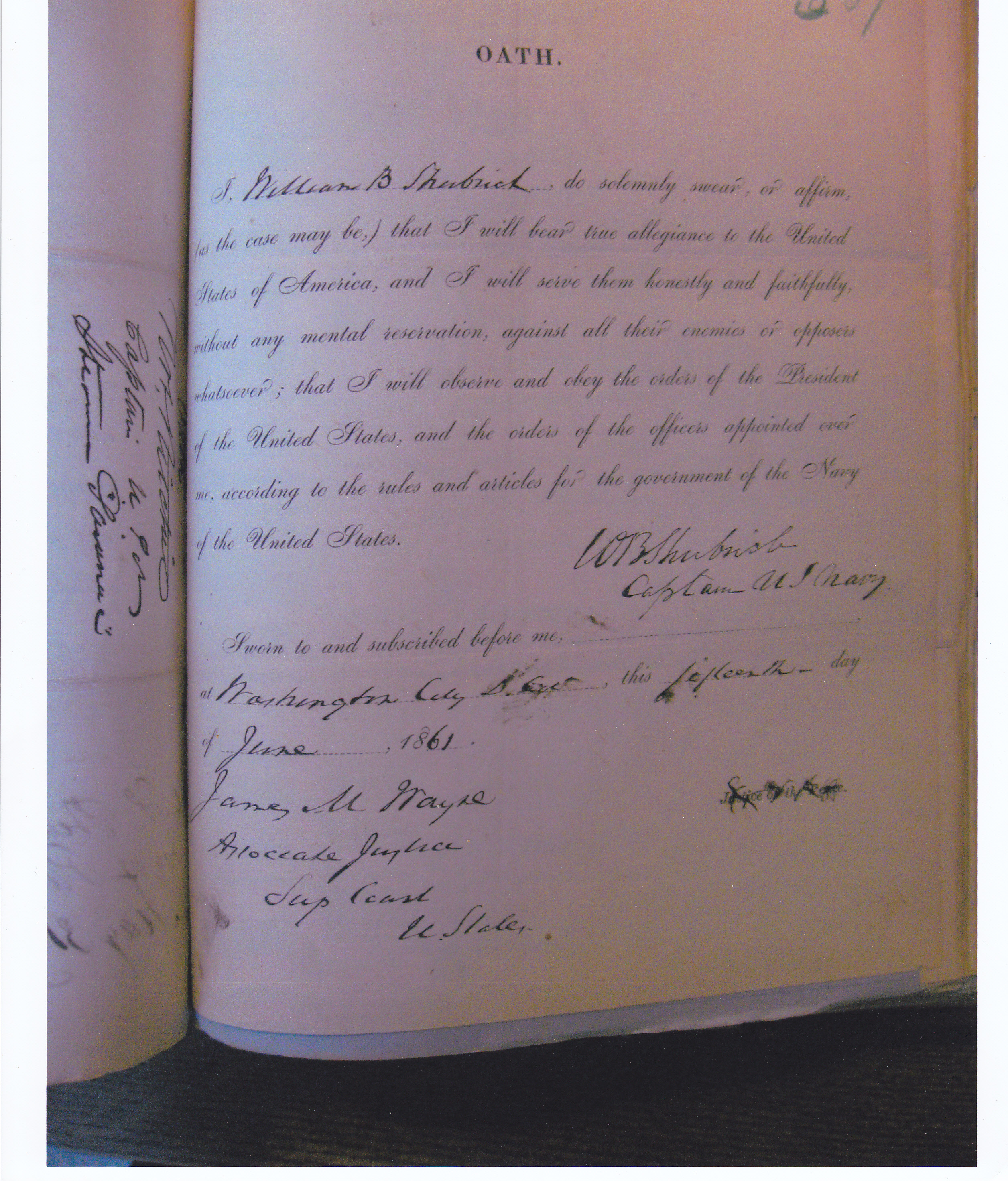On September 22, 1815 as William B. Shubrick, he married Harriet C. Wethered at Boston, Massachusetts.
William Branford Shubrick was an officer in the United States Navy. His active-duty career extended from 1806 to 1861, including service in the War of 1812 and the Mexican-American War; he retired in the early months of the Civil War. Born at Belvedere, Bull's Island, South Carolina, Shubrick studied at Harvard before accepting an appointment as a midshipman in 1806. He served in the Mediterranean on Wasp. It was aboard this ship where he met his life long friend James Fenimore Cooper. In 1809 he served in Argus along the Atlantic coast of the United States. After duty in the Hornet early in the War of 1812, he was assigned to the Constellation and while that frigate was at Norfolk, Virginia he led a party of bluejackets in beating off a British boat attack against Craney Island on June 22, 1813. He subsequently won a Congressional medal for service on the Constitution during her capture of HMS Cyane and Levant. During the more than three decades separating the War of 1812 from the Mexican-American War, Shubrick commanded, in turn, Lexington and Natchez; directed operation of the West Indies Squadron from 1838 to 1840 and headed the Bureau of Provisions and Clothing from 1845 to 1846. At the outbreak of the war with Mexico, Shubrick requested sea duty and in the Independence sailed for the California coast to relieve Commodore John D. Sloat in command of American Naval forces there. However, Commodore James Biddle brought his East India Squadron to Monterey, California on January 2, 1847 only a week after Shubrick's arrival and assumed command. In April Shubrick sailed for the coast of Mexico to head the blockade of Mazatlán and Guaymas. Early in June Shubrick was recalled to California where Biddle restored him to overall command on July 19 and sailed for the East Coast. Under Shubrick the Navy successfully conducted the closing operations of the war on the Pacific coast. Highlights were the capture of Guaymas in October and of Mazatlán in November. San Bias fell in January 1848. The following spring Shubrick headed home and took command of the Philadelphia Navy Yard in 1849. Beginning in 1853 he headed the Bureau of Construction and Repair and between 1854 and 1858 he chaired the Lighthouse Board. In October 1858 Shubrick sailed in command of the fleet sent to South American waters to support diplomatic efforts to resolve differences with Paraguay resulting from the firing upon USS Water Witch. In December 1861 Shubrick was retired; and he was promoted to Rear Admiral on the retired list on July 16, 1862. He died in Washington, D.C. on May 27, 1874.
Family: Three of his brothers were also officers in the United States Navy: John Templar Shubrick (1788-1815), Edward Rutledge Shubrick (1794-1844) and Irvine Shubrick (1798-1849). Several ships in the United States Navy have been named USS Shubrick for him.
On September 22, 1815 as William B. Shubrick, he married Harriet C. Wethered at Boston, Massachusetts.
William Branford Shubrick was an officer in the United States Navy. His active-duty career extended from 1806 to 1861, including service in the War of 1812 and the Mexican-American War; he retired in the early months of the Civil War. Born at Belvedere, Bull's Island, South Carolina, Shubrick studied at Harvard before accepting an appointment as a midshipman in 1806. He served in the Mediterranean on Wasp. It was aboard this ship where he met his life long friend James Fenimore Cooper. In 1809 he served in Argus along the Atlantic coast of the United States. After duty in the Hornet early in the War of 1812, he was assigned to the Constellation and while that frigate was at Norfolk, Virginia he led a party of bluejackets in beating off a British boat attack against Craney Island on June 22, 1813. He subsequently won a Congressional medal for service on the Constitution during her capture of HMS Cyane and Levant. During the more than three decades separating the War of 1812 from the Mexican-American War, Shubrick commanded, in turn, Lexington and Natchez; directed operation of the West Indies Squadron from 1838 to 1840 and headed the Bureau of Provisions and Clothing from 1845 to 1846. At the outbreak of the war with Mexico, Shubrick requested sea duty and in the Independence sailed for the California coast to relieve Commodore John D. Sloat in command of American Naval forces there. However, Commodore James Biddle brought his East India Squadron to Monterey, California on January 2, 1847 only a week after Shubrick's arrival and assumed command. In April Shubrick sailed for the coast of Mexico to head the blockade of Mazatlán and Guaymas. Early in June Shubrick was recalled to California where Biddle restored him to overall command on July 19 and sailed for the East Coast. Under Shubrick the Navy successfully conducted the closing operations of the war on the Pacific coast. Highlights were the capture of Guaymas in October and of Mazatlán in November. San Bias fell in January 1848. The following spring Shubrick headed home and took command of the Philadelphia Navy Yard in 1849. Beginning in 1853 he headed the Bureau of Construction and Repair and between 1854 and 1858 he chaired the Lighthouse Board. In October 1858 Shubrick sailed in command of the fleet sent to South American waters to support diplomatic efforts to resolve differences with Paraguay resulting from the firing upon USS Water Witch. In December 1861 Shubrick was retired; and he was promoted to Rear Admiral on the retired list on July 16, 1862. He died in Washington, D.C. on May 27, 1874.
Family: Three of his brothers were also officers in the United States Navy: John Templar Shubrick (1788-1815), Edward Rutledge Shubrick (1794-1844) and Irvine Shubrick (1798-1849). Several ships in the United States Navy have been named USS Shubrick for him.
Family Members
Advertisement
Advertisement















